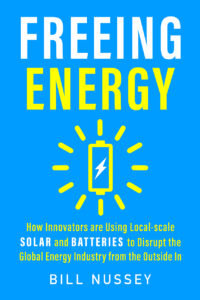In the world of clean energy, all paths lead to China. It is the largest buyer and the largest supplier of renewable energy on the planet. Chinese companies produce two-thirds of the world’s solar panels as well as two-thirds of all wind turbines (as of 2016). As a buyer, China installed 34 Gigawatts of solar in 2016, the same as the rest of the world combined. It also installed about 40% of the world’s new wind capacity.
To really understand China’s amazing rise to the world leader in clean energy, I traveled to the country to see firsthand how business is done there. I am going to post a series of blogs on what I learned, starting with the six things that surprised me and upended the conventional wisdom on China.
1 – China can move at a speed and scale no other country can match
Beijing and other Chinese cities have been full of bicycles for decades. But just two years ago, all those old bikes disappeared and were replaced by millions of brand new, yellow and blue bikes. Ofo and Mobike had been born. These two companies came from nowhere raising US$500m and US$300m respectively. They now have over 4 million bicycles on the streets of China which are shared by over 30 million users via their smartphone apps. The story of these bicycle companies is a small example of what China has done in solar and wind and will likely do in batteries and future renewable technology.
2 – Cheap labor is no longer a big advantage – China’s labor costs have skyrocketed
From 2000 to 2014, the cost of Chinese labor increased 600%. While it’s still cheaper than US-based labor, Chinese hourly labor actually became more expensive than Mexico’s in 2011. Most Chinese business people I talked to were already moving some of their labor-intensive manufacturing to less expensive countries like Malaysia.
GET MONTHLY NEWS & ANALYSIS
Unsubscribe anytime. We will never sell your email or spam you.
3 – The image of China as a top-down, centrally-run culture obscures the reality of a thriving entrepreneurial business community
The rules in China are certainly different than Western business but make no mistake, the country is full of mavericks and entrepreneurs. Jack Perkowski’s book, Managing the Dragon, says it well, “Most people assume that China is a bureaucratic monolith, ruled from on high in Beijing. Right off the bat, it’s important to understand that this couldn’t be further from the truth. China has historically been, and still is, highly decentralized.” Jack cites an old Chinese proverb to drive the point home: The Mountains Are High and the Emperor Is Far Away.
4 – Even though decision making is largely decentralized, the central government drives the country with a powerful and clear vision
Every five years, China’s leaders release a long-term plan for the country. In 2015, they published their 13th “five-year plan” which encompasses everything from economic development and healthcare to education and energy. The latest plan also increases their emphasis on renewable energy. The targets include: increasing renewable power capacity to 680 gigawatts (GW) by 2020 and making renewables 20% of the total power mix by 2030. To put this in perspective, one gigawatt can power up to 1,000,000 Western homes and the Hoover Dam outputs about 2 GW. The scale of their plans is breathtaking.
5 – There are two China’s when it comes to costs
China is a paradoxical mix of old and new. Our first morning in Shanghai, our breakfast buffet at the Hilton set us back US$30.00 per person. That same afternoon, we had lunch at a genuine Subway sandwich shop where a sandwich, chips and a drink cost less than US$4.00. The next day, a lunch of noodles and beef at a small Chinese restaurant was even less. Western companies struggle to make sense of these huge gaps. Chinese companies have grown up with these crazy cost differences and are able to embrace them to their advantage.
6 – There are two China’s when it comes to infrastructure
At 128 stories, the Shanghai Tower is the second tallest building in the world. Our factory visit 150 miles outside Shanghai took less than an hour on a bullet train that travels 180 MPH. But just past these amazing feats of engineering infrastructure, the city streets are a blur of people, bicycles, scooters, and cars. It is said that Chinese lane markings and speed limits are merely suggestions. The crosswalks have no signs – getting from one side to the other was perilous and felt like the old video game, Frogger. Like the costs, getting around China can be disorienting to a foreigner but the locals just take it all in stride. (I quickly learned the trick to crossing the streets – just wait for a local to show up and follow them.)
Mixing the old and the new
China isn’t what most people think – it’s a marvelous set of contradictions all rolled into one incredibly dynamic culture. There are few better examples of China’s future than Lei Zhang, the 40-year old CEO and founder of Envision Energy. Started in 2007, this company has grown to be one of the largest producers and operators of wind turbines on the planet. Envision is investing billions in renewable power in China and, increasingly, around the world. Lei has merged the experience from a family of entrepreneurs into the future industry of clean energy. At a dinner overlooking the Huangpu River and the bright lights of Pudong, I asked Lei what made him and, by extension, China, so uniquely successful in clean energy. Lei answered, “Nobody [else] thinks beyond 100 years.”
Note: special thanks to my friend Andy Klump, CEO of Shanghai-based Clean Energy Associates, and his colleagues, for opening up their networks of friends and partners.




2 Responses
Great post Bill, thanks for sharing. Love that last quote!
Hey Bill! I think we all need more people to embrace renewable energy, so it’s great you getting involved with this. Keep it up!